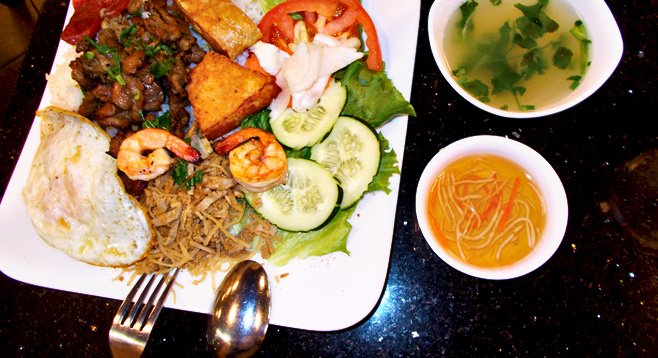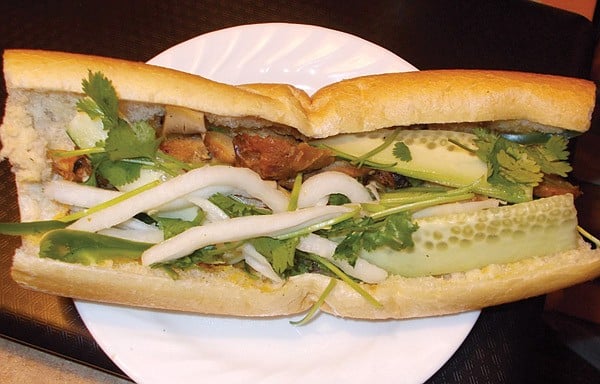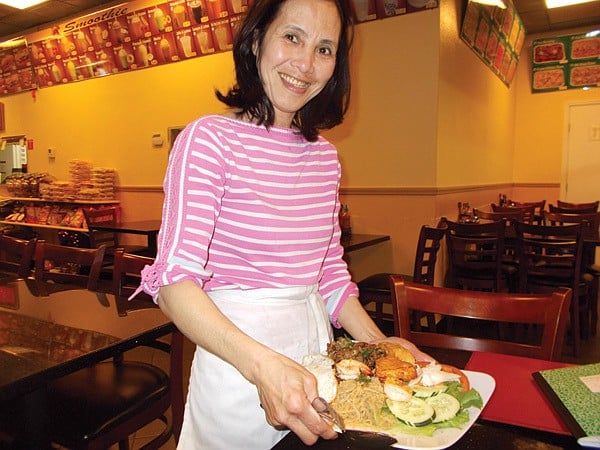 Facebook
Facebook
 X
X
 Instagram
Instagram
 TikTok
TikTok
 Youtube
Youtube

‘Sandwich: Buy 2, get 1 free.”
I see this sign when I get off the 44 bus.
It’s hanging outside a Vietnamese eatery I hadn’t noticed before. Another sign above it reads: “Bale Restaurant & Deli. Vietnamese, Chinese, Thai Cuisine.”
Hmm…we must be talking bánh mi, a Vietnamese adaptation of the French baguette sandwich. In the 1800s, when the French colonized Vietnam, they brought their bakeries to Hanoi and filled baguettes as usual with butter and pâté. It wasn’t until the Vietnamese shook off the French in 1954 that the “Vietnamization” of bánh mi began. They added some heat, made their own mayo mix, and added sweet pickled carrots, cucumber, a bit of soy, and cilantro. So, yes, bánh mi are basically western sandwiches, but the flavors are eastern.
Maybe if I bought three, ate one…left two to have later with Carla…?
Now I’m inside. It’s 8:00 p.m., one hour before closing. This Vietnamese gal in a pink-and-white version of a French sailor’s sweater stands behind the counter. Tina.
“Can I help you?” she asks.
“You have sandwiches?”

I mean, it’s like asking someone at McDonald’s if they have hamburgers. The bánh mi are displayed in photos all along the wall, above a red-and-gold plaque that reads “Khai Truong Hong Phat.” (“Good Luck on the Grand Opening.”)
“We have only been open eight months in this location,” Tina explains, “and which sandwich, please?”
They have dozens of choices, but she suggests that I have one pork, one beef, and one chicken. So I go for the #7, Bánh Mi Xa Xiu, sweet roasted pork. And the #13, BBQ beef. And #5, the BBQ chicken. The BBQ beef is $3.69, the other two are $3.39, but like it said on the sign, the third one is free.
So here’s where I start to make a simple thing complicated (typical me): while Tina’s writing all this down, I can’t help asking Tanh, the waiter, if they have anything apart from bánh mi.
“Of course,” he says, and swings a big glossy menu book in front of me. Pages and pages of items, each with its own color pic. One or two are given an entire page.
Bottom line, they have this luscious-looking Com Tam Ba Le, which is “Bale’s special broken rice dish,” for $8.99. Broken rice? Seen it mentioned before, but what the heck is it? I wanna try it. Maybe I could sneak this in while they’re making the sandwiches, then make a gift of all three bánh mi to Carla.
I sit down at a black marble-top table in the corner. Place has lots of windows, cream walls, sandy-colored wainscoting, plus endless photos of non–bánh mi dishes served here. I look around. A few people are still eating.
Pretty quick, Tina brings my broken rice. And, man, so much. First thought: this costs $8.99. In Little Italy, at the Queenstown pub, $9 buys a single giant pretzel.
I get Tanh to explain what-all I’ve got. He goes around in a circle, finger-pointing: “BBQ shrimp, BBQ pork, fried egg, shredded pork with peanut crumbles, pork sausage slices, shrimp patty, shrimp-and-ground-pork patty with bean-curd skin, egg loaf, which is a kind of omelet with clear bean-thread noodles, mushrooms, shrimp, pork, and crab, and the salad.”

Now he’s talking about the lettuce, tomato, cucumber slices, pickled-carrot shreds, and slices of pickled heart of cabbage that fill about a third of the crowded plate. Plus the chicken soup and the nuoc mam, Vietnamese fish sauce. That has carrot and daikon shreds in it. Smells fishy but sweet.
“We prepare everything here,” says Tanh. “Takes a long time. Two cooks.”
I pour that nuoc mam all over the barbecued pork pieces and the mound of rice underneath them, then add red chili and Sriracha sauce in goodly amounts. Then — oh, yes, totally delish — I start munching on white slices of pickled cabbage. Tangy, tart, terribly tasty.
I have to ask Tanh one thing. “What’s the deal about broken rice?”
“Broken rice is very Vietnamese,” he says. “We like it especially with pork.” He says it’s rice that’s been broken in the milling process — or in the drying-on-roads process — so it’s cheaper. It’s what ordinary people often eat and get used to. Oh, yeah. This is like what they call rice grits or middlins in, say, Carolina, land of that great Carolina Gold rice. The main thing about broken rice is that it absorbs the flavors of the food and liquids around it better than smooth-skinned whole rice grains. Also, it has a rougher texture.
By now it’s almost closing time. Vi, the mom, Tina, the daughter, Trang, another daughter, the other Tina who has been serving me, and the cooks are out and sitting around in the dining room, taking five at the end of the day. Me, I’m attacking the egg loaf. It’s dense. Packed with ’shrooms, shrimp, pork, and crab. Almost a meal in itself.
“We were all in a displacement camp in Hong Kong when I was a little girl,” says Trang. She’s 21 but looks way younger. “Then they sent us back to Vietnam. We finally made it here, and 13 years ago mom started our first restaurant. It was her dream. We have been in three locations now, all around this Linda Vista Plaza.”
I ask if she’s been back to Vietnam since coming to the States.
“Oh, yes. But the trouble is, like, culturally, I’ve been too whitened. I prefer the American way now. Back in Da Nang, they’re too cocky, strutty, don’t want to know other ways. To them I smell different, talk different, act different. Even my relatives saw me as a tourist.”
I’m the last customer to leave. All the staff are leaving with me. Couldn’t finish the broken rice, so I put it in with the three bánh mi I ordered. Carla’s into Vietnamese — I have high hopes.
Later: Carla and I agree that the daikon and cilantro make our sandwiches worthwhile. She has the pork, I have the chicken. So good. Pickled daikon flavors, garlic, a sweet tang. ’Course, no comparison to Bale’s broken-rice dish, because, hey, all that variety on one plate? Plus, in the end these bánh mi are, well, sandwiches.
But what deals! If it’s between these and a giant pretzel…


‘Sandwich: Buy 2, get 1 free.”
I see this sign when I get off the 44 bus.
It’s hanging outside a Vietnamese eatery I hadn’t noticed before. Another sign above it reads: “Bale Restaurant & Deli. Vietnamese, Chinese, Thai Cuisine.”
Hmm…we must be talking bánh mi, a Vietnamese adaptation of the French baguette sandwich. In the 1800s, when the French colonized Vietnam, they brought their bakeries to Hanoi and filled baguettes as usual with butter and pâté. It wasn’t until the Vietnamese shook off the French in 1954 that the “Vietnamization” of bánh mi began. They added some heat, made their own mayo mix, and added sweet pickled carrots, cucumber, a bit of soy, and cilantro. So, yes, bánh mi are basically western sandwiches, but the flavors are eastern.
Maybe if I bought three, ate one…left two to have later with Carla…?
Now I’m inside. It’s 8:00 p.m., one hour before closing. This Vietnamese gal in a pink-and-white version of a French sailor’s sweater stands behind the counter. Tina.
“Can I help you?” she asks.
“You have sandwiches?”

I mean, it’s like asking someone at McDonald’s if they have hamburgers. The bánh mi are displayed in photos all along the wall, above a red-and-gold plaque that reads “Khai Truong Hong Phat.” (“Good Luck on the Grand Opening.”)
“We have only been open eight months in this location,” Tina explains, “and which sandwich, please?”
They have dozens of choices, but she suggests that I have one pork, one beef, and one chicken. So I go for the #7, Bánh Mi Xa Xiu, sweet roasted pork. And the #13, BBQ beef. And #5, the BBQ chicken. The BBQ beef is $3.69, the other two are $3.39, but like it said on the sign, the third one is free.
So here’s where I start to make a simple thing complicated (typical me): while Tina’s writing all this down, I can’t help asking Tanh, the waiter, if they have anything apart from bánh mi.
“Of course,” he says, and swings a big glossy menu book in front of me. Pages and pages of items, each with its own color pic. One or two are given an entire page.
Bottom line, they have this luscious-looking Com Tam Ba Le, which is “Bale’s special broken rice dish,” for $8.99. Broken rice? Seen it mentioned before, but what the heck is it? I wanna try it. Maybe I could sneak this in while they’re making the sandwiches, then make a gift of all three bánh mi to Carla.
I sit down at a black marble-top table in the corner. Place has lots of windows, cream walls, sandy-colored wainscoting, plus endless photos of non–bánh mi dishes served here. I look around. A few people are still eating.
Pretty quick, Tina brings my broken rice. And, man, so much. First thought: this costs $8.99. In Little Italy, at the Queenstown pub, $9 buys a single giant pretzel.
I get Tanh to explain what-all I’ve got. He goes around in a circle, finger-pointing: “BBQ shrimp, BBQ pork, fried egg, shredded pork with peanut crumbles, pork sausage slices, shrimp patty, shrimp-and-ground-pork patty with bean-curd skin, egg loaf, which is a kind of omelet with clear bean-thread noodles, mushrooms, shrimp, pork, and crab, and the salad.”

Now he’s talking about the lettuce, tomato, cucumber slices, pickled-carrot shreds, and slices of pickled heart of cabbage that fill about a third of the crowded plate. Plus the chicken soup and the nuoc mam, Vietnamese fish sauce. That has carrot and daikon shreds in it. Smells fishy but sweet.
“We prepare everything here,” says Tanh. “Takes a long time. Two cooks.”
I pour that nuoc mam all over the barbecued pork pieces and the mound of rice underneath them, then add red chili and Sriracha sauce in goodly amounts. Then — oh, yes, totally delish — I start munching on white slices of pickled cabbage. Tangy, tart, terribly tasty.
I have to ask Tanh one thing. “What’s the deal about broken rice?”
“Broken rice is very Vietnamese,” he says. “We like it especially with pork.” He says it’s rice that’s been broken in the milling process — or in the drying-on-roads process — so it’s cheaper. It’s what ordinary people often eat and get used to. Oh, yeah. This is like what they call rice grits or middlins in, say, Carolina, land of that great Carolina Gold rice. The main thing about broken rice is that it absorbs the flavors of the food and liquids around it better than smooth-skinned whole rice grains. Also, it has a rougher texture.
By now it’s almost closing time. Vi, the mom, Tina, the daughter, Trang, another daughter, the other Tina who has been serving me, and the cooks are out and sitting around in the dining room, taking five at the end of the day. Me, I’m attacking the egg loaf. It’s dense. Packed with ’shrooms, shrimp, pork, and crab. Almost a meal in itself.
“We were all in a displacement camp in Hong Kong when I was a little girl,” says Trang. She’s 21 but looks way younger. “Then they sent us back to Vietnam. We finally made it here, and 13 years ago mom started our first restaurant. It was her dream. We have been in three locations now, all around this Linda Vista Plaza.”
I ask if she’s been back to Vietnam since coming to the States.
“Oh, yes. But the trouble is, like, culturally, I’ve been too whitened. I prefer the American way now. Back in Da Nang, they’re too cocky, strutty, don’t want to know other ways. To them I smell different, talk different, act different. Even my relatives saw me as a tourist.”
I’m the last customer to leave. All the staff are leaving with me. Couldn’t finish the broken rice, so I put it in with the three bánh mi I ordered. Carla’s into Vietnamese — I have high hopes.
Later: Carla and I agree that the daikon and cilantro make our sandwiches worthwhile. She has the pork, I have the chicken. So good. Pickled daikon flavors, garlic, a sweet tang. ’Course, no comparison to Bale’s broken-rice dish, because, hey, all that variety on one plate? Plus, in the end these bánh mi are, well, sandwiches.
But what deals! If it’s between these and a giant pretzel…
Comments